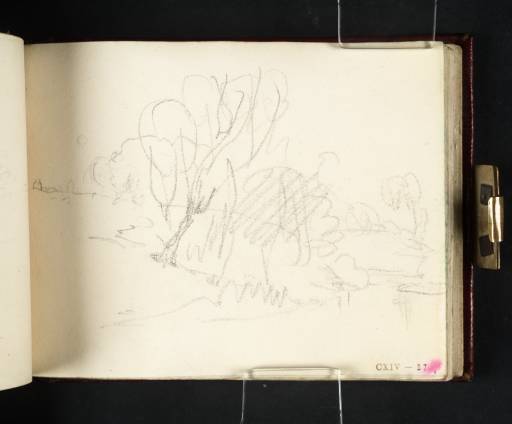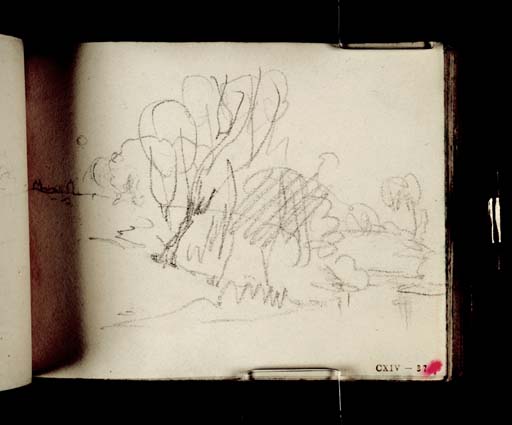Joseph Mallord William Turner Trees beside the River Brent c.1808-11
Image 1 of 2
Joseph Mallord William Turner,
Trees beside the River Brent
c.1808-11
Joseph Mallord William Turner 1775–1851
Folio 37 Recto:
Trees beside the River Brent circa 1808–11
D08009
Turner Bequest CXIV 37
Turner Bequest CXIV 37
Pencil on white wove paper, 87 x 117 mm
Inscribed by John Ruskin in red ink ‘37’ bottom right (smudged)
Stamped in black ‘CXIV – 37’ bottom right
Inscribed by John Ruskin in red ink ‘37’ bottom right (smudged)
Stamped in black ‘CXIV – 37’ bottom right
Accepted by the nation as part of the Turner Bequest 1856
References
1909
A.J. Finberg, A Complete Inventory of the Drawings of the Turner Bequest, London 1909, vol.I, p.312, CXIV 37, as ‘Banks of river’.
This sketch appears to be the direct source of the oil painting On the River Brent (private collection)1 and a watercolour version of almost the same size, View on the River Brent (private collection).2 The sketchy lines of the trunk and branches of the nearest tree can be followed with slight variations in both works, where the zigzag along the water’s edge becomes a bed of reeds. The hillside is continued a little to the left on folio 36 verso opposite (D08008) and the river to the right on folio 38 recto (D08010). The sketches running from folio 28 recto (D07999) onwards, particularly that on folios 34 verso–35 recto (D41527, D08006), were perhaps made nearby.
The River Brent meanders south through what is now north-west London before merging with the Grand Union Canal at Hanwell and flowing into the Thames at Brentford to the south-east, near Isleworth and Kew; the general area was well known to Turner and a source of many works.3 The Brent’s confluence with the canal is just east of the site traditionally identified as the location of Turner’s oil Grand Junction Canal at Southall Mill, exhibited at his gallery in 1810 (currently untraced);4 there are sketches relating to that painting on folios 71 verso–72 recto and 72 verso–73 recto (D08053–D08056).
The oil version of the present scene has been dated by Butlin and Joll to about 1807–9 by stylistic comparison with Hurley House on the Thames (private collection),5 itself dated by its similarities with Cliveden on Thames, which was possibly exhibited in 1807 (Tate N01180),6 although further comparisons are made with Cockermouth Castle, exhibited in 1810 and taken from drawings of 1809 (Tate T03879; displayed at Petworth House, Sussex).7 Hence a date of about 1809 or 1810 seems feasible for the Brent oil; the watercolour, probably made as a fairly free replica, was dated ‘?c.1807’ by Andrew Wilton when it had been long untraced.8 Butlin and Joll accepted this dating when it subsequently reappeared,9 but assuming the present drawing is the source for both the oil and the watercolour, they cannot have been made earlier than 1808 (the watermarked date on other pages in this sketchbook), and Edward Yardley has put the watercolour as late as about 1815–22.10
Martin Butlin and Evelyn Joll, The Paintings of J.M.W. Turner, revised ed., New Haven and London 1984, pp.124–5 no.198, pl.198.
Martin Butlin and Evelyn Joll, The Paintings of J.M.W. Turner, revised ed., New Haven and London 1984, pp.72–3 no.101, pl.108 (colour); Martin Butlin, ‘Lost, stolen and destroyed works’, in Evelyn Joll, Butlin and Luke Herrmann eds., The Oxford Companion to J.M.W. Turner, Oxford 2001, p.178, as stolen in 1991.
Verso:
Blank
Matthew Imms
January 2012
How to cite
Matthew Imms, ‘Trees beside the River Brent c.1808–11 by Joseph Mallord William Turner’, catalogue entry, January 2012, in David Blayney Brown (ed.), J.M.W. Turner: Sketchbooks, Drawings and Watercolours, Tate Research Publication, December 2012, https://www


